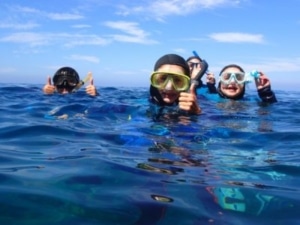
While most animals found on the sandy bottom areas around CIMI spend most of their time trying to blend in with the sand, the Navanax (Navanax inermis) sticks out like a clown at a camouflage convention. Some head shield slugs and their colorful relatives Nudibranchs have opted out from hiding and instead use colorful displays to send out the message of “yea, I know you can see me, come at me bro…” They spend their time searching the sand for slime trails left by other snails and slugs. Navanax use chemoreceptors on the front of their body to follow these trails of slimy mucous and use their impressive (for a slug) speeds to catch up with, and then devour, their prey.
[vc_row][vc_column width=”2/3″][vc_column_text]Navanax will also use this “follow the slime” method to find potential mates. When two of them meet they will first try to eat each other and if that is unsuccessful (usually because they are the exact same size) they will then mate. Scientists have learned a lot about defense mechanisms of other slugs and snails by tracking and recording the eating preferences of the Navanax. Basically, if an eating machine like the Navanax doesn’t want to eat an animal, then that animal is doing something right![/vc_column_text][/vc_column][vc_column width=”1/3″][vc_single_image image=”6841″ img_size=”large” alignment=”center”][vc_column_text]Writing and Photo Credit: Phil Lemley[/vc_column_text][/vc_column][/vc_row]



